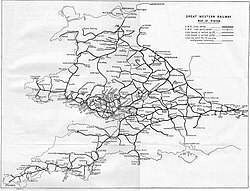| Class | Wheels | Introduced | Final TVR nos. | Quantity | First GWR nos. | To BR | Extinct | Notes | Ref |
|---|
| A | 0-6-2T | 1914 | 3, 7, 10–12, 20, 42/5, 52, 75, 80, 90/1, 120/2–5/7–130/2–6/8–140/4/9, 154/6–160/2/4/5, 400–416 | 58 | 335/7, 343–9, 351/2/6/7, 360–2/4–8, 370–391/3/4/7–9, 401–4/6/8, 438–441 | 58 | 1957 | GWR nos. 401 up allotted 303–9, 312/6, 322 in 1946, renumbered 1947–50 | |
| C | 4-4-2T | 1888 | 170–5 | 6 | 1301–6 | — | 1927 | | |
| D | 0-6-0ST | 1865 | 250, 270 | 2 | 797/8 | — | 1926 | | |
| E | 0-6-0ST | 1873 | 264–5 | 2 | 795/6 | — | 1927 | | |
| H | 0-6-0T | 1884 | 141–3 | 3 | 792–4 | 3 | 1953 | Renumbered 193–5 during 1948/49 | |
| I | 4-4-0T | 1884 | 285–7 | 3 | 999, 1133, 1184 | — | 1925 | | |
| K & L | 0-6-0 | 1874 | 210/7/9, 220, 235/6/9, 242/5, 252/3/9, 261, 281/3/4/8, 297/8, 301/2/4, 313–6, 320/2/5/7/8, 335–7/9, 340, 354/6–360 | 42 | 912–933/5/6/8/9, 941–4/6/8, 968–970/4/8, 984, 1000–2 | — | 1930 | 43 withdrawn 1907–20 | |
| M & M1 | 0-6-2T | 1885 | 4, 5, 14–16, 22/4, 50/1/3/4, 71/4, 86–89, 145–8, 150–3, 163/6–9, 176–181, 344/9, 362/4/5 | 41 | 442–5, 462/6, 478, 481–4/7–493, 503/5–8, 511/3/5/6, 520, 552, 560/7, 573/7–580/2–6 | — | 1934 | | |
| N | 0-6-2T | 1891 | 106/7, 182–9 | 10 | 485/6, 494–6, 498–502 | — | 1934 | | |
| O | 0-6-2T | 1894 | 21/5/6, 33/4, 190 | 6 | 446–8, 452/3, 581 | — | 1930 | | |
| O1 | 0-6-2T | 1894 | 27–29, 37, 41, 60–65, 70/3/8 | 14 | 449–451/4/5, 471–7/9, 480 | — | 1931 | | |
| O2 | 0-6-2T | 1899 | 31/2, 44, 66, 81–5 | 9 | 412/3/5/9, 421/3–6 | — | 1928 | | |
| O3 | 0-6-2T | 1902 | 18/9, 47, 55/7, 92/3/6, 103, 117, 126, 131/7, 155, 161 | 15 | 410/1/6–8, 427–35/7 | 2 | 1948 | Nos. 410/1 to BR | |
| O4 | 0-6-2T | 1907 | 1, 2, 6, 8, 9, 13/7, 35/6/8/9, 43/6/8/9, 56/8/9, 67–9, 94/5/7/8, 101/2/4/5/8–116/8/9, 121 | 41 | 236, 278–302, 310/1/3–5/7–321/4, 333, 409, 414, 420 | 41 | 1955 | Nos. 300 up allotted 200–211, 215–220 in 1946; except for 301/2, 314 these were renumbered in 1946–50. | |
| S & T | 0-4-0ST | 1876 | 266/7 | 2 | 1342/3 | — | 1926 | | |
| U & U1 | 0-6-2T | 1895 | 23, 30, 40, 72/6/7/9, 191–198 | 15 | 587–593/5–600/2/3 | — | 1931 | | |
| V | 0-6-0ST | 1899 | 99, 100, 275, 280, 290/1 | 6 | 786–791 | — | 1930 | | |
